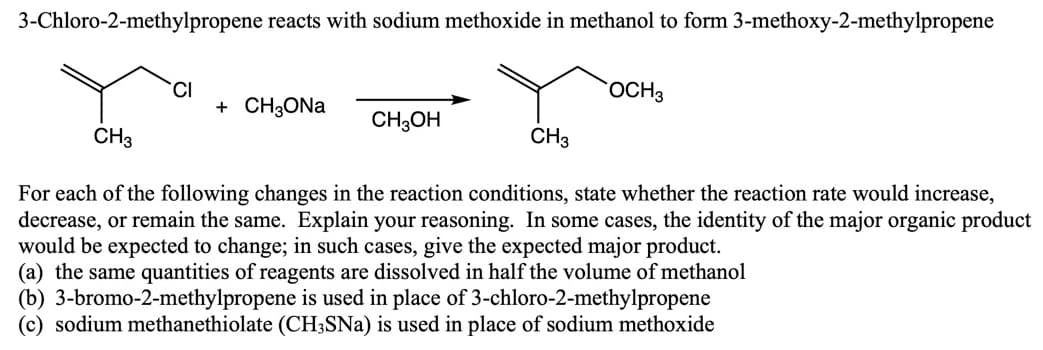3-Chloro-2-methylpropene reacts with sodium methoxide in methanol to form 3-methoxy-2-methylpropene. For each of the following changes in the reaction conditions, state whether the reaction rate would increase, decrease, or remain the same. Explain your reasoning. In some cases the identity of the major organic product would be expected to change; in such cases, give the expected major product. (a) the same quantities of reagents are dissolved in half the volume of methanol (b) 3-bromo-2-methylpropene is used in place of 3-chloro-2-methylpropene (c) sodium methanethiolate (CH3SNa) is used in place of of sodium methoxide
3-Chloro-2-methylpropene reacts with sodium methoxide in methanol to form 3-methoxy-2-methylpropene. For each of the following changes in the reaction conditions, state whether the reaction rate would increase, decrease, or remain the same. Explain your reasoning. In some cases the identity of the major organic product would be expected to change; in such cases, give the expected major product. (a) the same quantities of reagents are dissolved in half the volume of methanol (b) 3-bromo-2-methylpropene is used in place of 3-chloro-2-methylpropene (c) sodium methanethiolate (CH3SNa) is used in place of of sodium methoxide
Chapter19: Aldehydes And Ketones: Nucleophilic Addition Reactions
Section19.SE: Something Extra
Problem 28VC
Related questions
Question
3-Chloro-2-methylpropene reacts with sodium methoxide in methanol to form 3-methoxy-2-methylpropene.
For each of the following changes in the reaction conditions, state whether the reaction rate would increase, decrease, or remain the same. Explain your reasoning. In some cases the identity of the major organic product would be expected to change; in such cases, give the expected major product.
(a) the same quantities of reagents are dissolved in half the volume of methanol
(b) 3-bromo-2-methylpropene is used in place of 3-chloro-2-methylpropene
(c) sodium methanethiolate (CH3SNa) is used in place of of sodium methoxide

Transcribed Image Text:3-Chloro-2-methylpropene reacts with sodium methoxide in methanol to form 3-methoxy-2-methylpropene
OCH3
CI
+ CH3ONA
CH;OH
CH3
CH3
For each of the following changes in the reaction conditions, state whether the reaction rate would increase,
decrease, or remain the same. Explain your reasoning. In some cases, the identity of the major organic product
would be expected to change; in such cases, give the expected major product.
(a) the same quantities of reagents are dissolved in half the volume of methanol
(b) 3-bromo-2-methylpropene is used in place of 3-chloro-2-methylpropene
(c) sodium methanethiolate (CH;SNa) is used in place of sodium methoxide
Expert Solution
This question has been solved!
Explore an expertly crafted, step-by-step solution for a thorough understanding of key concepts.
This is a popular solution!
Trending now
This is a popular solution!
Step by step
Solved in 2 steps

Knowledge Booster
Learn more about
Need a deep-dive on the concept behind this application? Look no further. Learn more about this topic, chemistry and related others by exploring similar questions and additional content below.Recommended textbooks for you


Organic Chemistry
Chemistry
ISBN:
9781305580350
Author:
William H. Brown, Brent L. Iverson, Eric Anslyn, Christopher S. Foote
Publisher:
Cengage Learning


Organic Chemistry
Chemistry
ISBN:
9781305580350
Author:
William H. Brown, Brent L. Iverson, Eric Anslyn, Christopher S. Foote
Publisher:
Cengage Learning